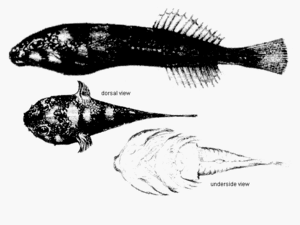Gobiesox marmoratus
| Gobiesox marmoratus | ||||||||||||
|---|---|---|---|---|---|---|---|---|---|---|---|---|

Drawing from the first description |
||||||||||||
| Systematics | ||||||||||||
|
||||||||||||
| Scientific name | ||||||||||||
| Gobiesox marmoratus | ||||||||||||
| Jenyns , 1842 |
Gobiesox marmoratus is a small marine fish from the family of tortoiseshell fish(Gobiesocidae). In Spanish (e.g. in Chile) it is given the common name pejesapo veteado , which means "speckled toad fish ".
features
Head and back are irregularly lightly spotted with a dark brown basic color and a light underside. As for the body shape, it can be described as a miniature version of an anglerfish ( Lophius ). The mouth is not flat, but the lower jaw is bent up at the front and the upper jaw is accordingly drawn in a little in the middle.
The head is as wide as it is long (almost a third of the total length), flat and round, so that the fish is almost pan- shaped (or banjo ) when viewed from the back : the large mouth barely protrudes. The trunk and tail are increasingly compressed, much narrower than the head. The mouth reaches below the eye, so it is very wide. The teeth are strong, they stand in front in groups in the upper jaw, are conical, e.g. Partly curved; they get smaller towards the corners of the mouth and are only in a row; in the lower jaw the front six teeth are directed forward and are incisor-like; On both sides there are two or three similar, loosely standing - the dentition of the two jaws is therefore strikingly different (cf.Gregory 1933; the images of the skull there, however, do not show Gobiesox , but the related Sicyases with his horse teeth).
The gill openings are wide (different from Lepadogaster ), with six Branchiostegalradien that protrude a little behind. The gill cover also ends in a slightly protruding blunt point above the base of the pectoral fin. The dorsal fin begins a little after the middle of the total length and ends at some distance from the rounded caudal fin; its first ray is shorter. The anal fin begins about under the fourth ray of the dorsal fin and ends a track after its rear end. (This position, similar to that of the pike ( Esox ), justifies the generic name: "goby pike".)
The abdominal suction cup is almost as big as the head and in two parts: the front part broadly crescent-shaped encompasses the smaller, rear, rounded one (see Lepadogaster lepadogaster ). The front part in particular has numerous papillae on the surface, which apparently serve to hold the body mucus that covers the animal as protection. These papillae are also found elsewhere, especially on the head (on the underside; on the "upper lip"). The broad pectoral fins can also contribute to the adhesive function ventrally when turned over. Johannes Müller therefore writes in the “ Horae ichthyologicae ” (1849) that the pectoral and pelvic fins appeared doubled, since the latter each had a deep fold towards the interior of the suction cup.
The fin formula is: D 13; A 11; C 14-15; P 20-21, V (1 /) 4th-29 vertebrae. The size of the fish is up to 15 cm.
behavior
Although G. marmoratus is not an intertidal fish, it can, e.g. B. in seaweed, remain out of the water at low tide and must then be able to "breathe air". Reproduction happens as with Lepadogaster . The larvae hatch in the open water just under 5 mm long and come back from the plankton to the littoral with a length of 18-20 mm (Perez 1981). The diet consists mainly of isopods and the like. Ä., Of course from time to time also from small fish. Thanks to their wide mouth, throat and stomach, these fish can also B. devour limpets of considerable size, whose shell is then slowly decalcified in the stomach.
distribution
The species occurs on the subtropical, rocky coasts of Uruguay , Argentina , Chile and Peru . In some places it can have the highest number of individuals of all fish in the biotope.
Discovery story
Leonard Jenyns described the by Charles Darwin on his voyage around the world (in early summer 1834/5) in the archipelago of Chiloe discovered fish (see above). At that time, the shield bellies were thought to be relatives of the disk bellies , that is, dragon-head-like - a view that still or again finds some followers today.
Systematics
Approx. 30 very similar species of the genus Gobiesox (maximum 16 cm long) live mostly sublittoral on the American coasts (mainly Central and South America), some also in brackish water, and a few even only in rivers up to the mountains, where a suction cup is again very useful .-- Some are extremely common in their biotopes.
literature
- PAQuijada, M. Caceres and W. Cristian (2000): Abundance, trophic composition and spatial distribution of the intertidal fish assemblage of South-central Chile.- Rev. chil. Hist. Nat. 73: 739-747.
- MC Pardo-Gandarillas, F. Garcías y Mario George-Nascimento (2004): La dieta y fauna de endoparásitos del pejesapo Gobiesox marmoratus Jenyns, 1842 (Pisces: Gobiesocidae) en el litoral central de Chile están conectadas pero no correlacionadas.- Rev. chil. hist. nat. 77: 627-637.
- R. Perez (1981): Desarrollo embrionario y larval de los pejesapos Sicyases sanguineus y Gobiesox marmoratus en la Bahía de Valparaíso, Chile, con notas sobre su reproducción (Gobiesocidae: Pisces) .- Invest. mar. Valparaíso 9: 1-24.
Individual evidence
- ↑ http://www.archive.org/stream/fishskullsstudyo00gregrich
- ↑ http://www.archive.org/stream/horaeichthyologi0102ml/horaeichthyologi0102ml_djvu.txt
Web links
- Gobiesox marmoratus on Fishbase.org (English)
- Skull, teeth